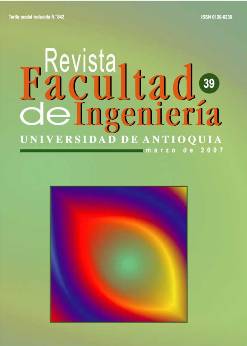Use of a flow balance method for the evaluation of the hydrologic behavior of the wetland “ciénaga de Cachimbero”
DOI:
https://doi.org/10.17533/udea.redin.20190Keywords:
wetland, water balance, hydrology, flow balance modelAbstract
The Wetland “ciénaga de Cachimbero”, located in the municipality of Cimitarra, Santander, has ecological and environmental importance for the region. It has been inventoried by the Ministry of the Environment and been catalogued as Palustral. A combined modeling and experimental approach to the hydrology of the wetland was carried out aiming at establishing a temporal evaluation scheme; the principal components of the water balance were determined. A scheme of observation and analysis of the hydrological variables, allowing the modeling of the flow balance, was implemented. The main objective of this work was then to formulate a dailyscale operative model of the natural hydrology behavior of the wetland aimed at the prediction of the temporal patterns of the water level and volume variations. It was found that the hydrology behavior is primarily controlled by the rain patterns, the morphometric characteristics of the basin (bathymetry), the evapotranspiration processes, and the flow patterns of the river that communicates the wetland with the Magdalena River.
Downloads
References
Ministerio del medio ambiente. Política nacional para humedales interiores de Colombia. Estrategias para su conservación y uso racional. Bogotá. Colombia. 2001. p. 52.
L. Hawk, A. P. Lipstein, H.T. Solanki. Wetland Hydroperiod Analysis. Proc. 6th Biennial Stormwater Research & Watershed Management Conference. Tampa, Florida, South West Florida Water Management District. September 14-17, 1999. pp. 216-225 URL: http://www.stormwater-resources.com/Library/107WWetlandHydroperiod.pdf. Consultada en octubre de 2004.
J.C., Múnera, J. I. Vélez. “Dinámica Hidrológica de la Ciénaga Grande de Santa Marta”. Avances en Recursos Hidráulicos. N.º 10, 2003. pp. 47-62.
V, Carter. Technical Aspects of Wetlands: Wetland Hydrolo-gy, Water Quality, and Associated Functions. J.D. Fretwell, J.S. Williams, P.J. Redman (eds.), National Water Summary on Wetland Resources. United States Geological Survey Water Supply Paper 2425. 1996. 24 pp. URL: http://water.usgs.gov/nwsum/WSP2425/hydrology.html. Consultada en octubre de 2004.
A. Maestre, M. Díaz-Granados. “Balance hídrico de ciénagas: modelación matemática e implementación con un sistema de información geográfica”. Memos de investigación CIFI. No 251. Universidad de los Andes. Bogotá. 1996. pp. 15.
C. J. Arbuckle, A.D. Huryn, S. A. Israel. Applications of Remote Sensing and GIS to Wetland Inventory: upland bogs. Tenth Annual Colloquium of the Spatial Information Research Center: University of Otago, Dunedin, New Zealand. 1998. pp. 15-24. URL: http://divcom.otago.ac.nz/sirc/webpages/Conferences/SIRC98/98Abstracts/4/Arbuckle.pdf. Consultada en octubre 2004.
J. C. Restrepo, J. L Toro. Reserva Natural Laguna de Cachimbero: Caracterización Biofísica. CORANTIOQUIA-Corporación Laguna de Cachimbero. Medellín. 1997. pp. 60.
F. Quintero, J. I. Vélez. “La cuenta física del agua mediante modelación hidrológica distribuida”. Gestión y Ambiente. Vol. 8. 2005. pp. 95-104.
J. I. Vélez, G. Poveda, O. Mesa. Balances hidrológicos de Colombia. Postgrado en Aprovechamiento de Recursos Hidráulicos. Universidad Nacional de Colombia sede Medellín Colombia. 2000. pp.150.
L. Turc “Estimation of irrigation water requirements, potencial evapotranspiration: A simple climatic formula evolved up to date”. Ann Agron. N.º 12.1962, pp.13-49
C.W Thornthwaite, J.R Mather,. “Instructions and tables for computing potential evapotranspiration and the water balance”. Climatology. N.º 10: 1957. pp.183-311
E.T Linacre. “A simple formula for estimating evaporation rates in various climates, using temperature data alone”. Agric. Meteorol. N.º 18. 1977. pp. 409-424. DOI: https://doi.org/10.1016/0002-1571(77)90007-3
Downloads
Published
How to Cite
Issue
Section
License
Revista Facultad de Ingeniería, Universidad de Antioquia is licensed under the Creative Commons Attribution BY-NC-SA 4.0 license. https://creativecommons.org/licenses/by-nc-sa/4.0/deed.en
You are free to:
Share — copy and redistribute the material in any medium or format
Adapt — remix, transform, and build upon the material
Under the following terms:
Attribution — You must give appropriate credit, provide a link to the license, and indicate if changes were made. You may do so in any reasonable manner, but not in any way that suggests the licensor endorses you or your use.
NonCommercial — You may not use the material for commercial purposes.
ShareAlike — If you remix, transform, or build upon the material, you must distribute your contributions under the same license as the original.
The material published in the journal can be distributed, copied and exhibited by third parties if the respective credits are given to the journal. No commercial benefit can be obtained and derivative works must be under the same license terms as the original work.










 Twitter
Twitter